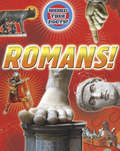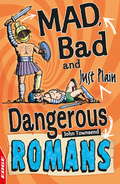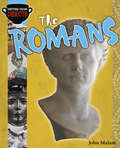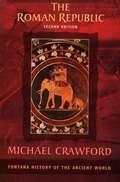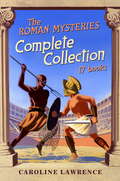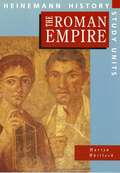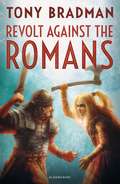Special Collections
Romans (rotten or not!)
Description: Images and books to support project and theme based learning on Roman history.
- Table View
- List View
Romans
by Moira ButterfieldTruth is a lot stranger than fiction! Weird True Facts includes the most eye-popping animals, vehicles and objects, the weirdest stories, the most astonishing facts and the most unbelievable situations EVER.
Romans
by John TownsendTime to take a sideways look at the bizarre and outrageous from throughout history - and it's all TRUE!Which mad idea poisoned thousands of Romans?Which bad emperor was top of the crazy tree? What dangerous sport was most likely to get you killed?Find out the answers to these questions inside, along with lots of facts, quizzes, and other bonkers stuff as you take a bumpy journey into the darkest crannies of Roman history with Mad, Bad and Just Plain Dangerous!
The Romans
by John MalamThrough examining primary evidence, such as coins, helmets, remains, sculptures, buildings and mosaics, the reader will be introduced to this historical age. Find out what toys roman children played with, what clothes people wore and what religion romans followed. Do the multiple choice quiz at the end to find out what you have learnt.
Roman road - cross section (UEB Uncontracted)
by Rnib BookshareAn image border surrounds this image of a cross section of a Roman road, with a key explaining what the different lines represent, at the bottom of the page. There is a locator dot shown, which will be at the top left of the page when the image is the right way up. On the far left and far right side of the page, normal ground soil is shown, and in the centre of the image, four horizontal layers of material which make up the road. On the left and right side of the top layer are drainage ditches, which the water run-off from the road would drain into.
Roman road - cross section (UEB Contracted)
by Rnib BookshareAn image border surrounds this image of a cross section of a Roman road, with a key explaining what the different lines represent, at the bottom of the page. There is a locator dot shown, which will be at the top left of the page when the image is the right way up. On the far left and far right side of the page, normal ground soil is shown, and in the centre of the image, four horizontal layers of material which make up the road. On the left and right side of the top layer are drainage ditches, which the water run-off from the road would drain into.
Roman road - cross section (Large Print)
by Rnib BookshareAn image border surrounds this image of a cross section of a Roman road, with a key explaining what the different lines represent, at the bottom of the page. There is a locator dot shown, which will be at the top left of the page when the image is the right way up. On the far left and far right side of the page, normal ground soil is shown, and in the centre of the image, four horizontal layers of material which make up the road. On the left and right side of the top layer are drainage ditches, which the water run-off from the road would drain into.
The Roman Republic (Fontana History of the Ancient World) (PDF)
by Michael CrawfordBetween the Sack of Rome by the Gauls in 390 BC and the middle of the second century BC, a part-time army of Roman peasants, under the leadership of the ruling oligarchy, conquered first Italy and then the whole of the Mediterranean. The loyalty of these marrauding heroes, and of the Roman population as a whole, to their leaders was assured by a share in the rewards of victory, rewards which became steadily less accessible as the empire expanded - promoting a decline in loyalty of cataclysmic proportions.Wars, rural impoverishments, civil discord and slavery are a few of the subjects covered in this study.
Roman Numerals (UEB uncontracted)
by RnibThis image shows Roman numerals 1 to 10 and numbers 1, 5, 10, 50, 100, 500, 1000. It also shows 2014 as a Roman numeral.
Roman Numerals (UEB contracted)
by RnibThis image shows Roman numerals 1 to 10 and numbers 1, 5, 10, 50, 100, 500, 1000. It also shows 2014 as a Roman numeral.
Roman Numerals (large print)
by RnibThis image shows Roman numerals 1 to 10 and numbers 1, 5, 10, 50, 100, 500, 1000. It also shows 2014 as a Roman numeral.
Roman Mysteries Complete Collection
by Caroline LawrenceA bumper eBook collection of all 17 Roman Mysteries adventures including The Thieves of Ostia, The Secrets of Vesuvius, The Pirates of Pompeii, The Assassins of Rome, The Dolphins of Laurentum, The Twelve Tasks of Flavia Gemina, The Enemies of Jupiter, The Gladiators From Capua, The Colossus of Rhodes, The Fugitive From Corinth, The Sirens of Surrentum, The Charioteer of Delphi, The Slave-Girl From Jerusalem, The Beggar of Volubilis, The Scribes From Alexandria, The Prophet From Ephesus and The Man From Pomegranate Street.Packed with action, mystery and adventure!
Roman mosaic
by Rnib BookshareThis image shows a diagram of a mosaic and a diagram of a detail of the mosaic. There is a locator dot shown, which will be at the top left of the page when the image is the correct way up. There is the complete but simplified mosaic on the left of the page and a detail showing the tiles that make up part of the mosaic on the right of the page. A traditional Roman mosaic is made of a great number of differently coloured tile fragments. In the image on the right the tiles are shown significantly larger than in real life so it will work tactually. The diagram on the left shows an image of a duck seen from the side facing left, both legs can be found but only one eye and wing is shown. It is surrounded by decorative fronds and vine leaves. The ducks head is towards the top left of the image with the beak pointing left and down. From the head the neck curves down and left to the body. At the base of the neck there is a part ring of white. In the centre of the body a bolder line that curves down and right represents the wing. Towards the tail on the right there is a patch of paler colour. Down from the body are the two legs and wide feet. On the left of the image is an area representing leaves. From them come curling tendrils in two shades of green - dashed and solid lines. To the right of the ducks head is a circular flower head. It has various rings of colour getting smaller to the centre. A wiggly stem goes down and right to the edge of the image. Halfway along it has a leaf up and down from the stem. At the bottom right are more vine leaves and one decorative frond. A line of very dark green tiles surrounds the image. At the top and bottom these are two tiles wide. An image border surrounds the image on the right. Most of the image is the duck enlarged from the image on the left. The duck fills the centre of the image and is shown in tiles, mainly a green colour. The ducks head is in the top left of the image with the beak pointing left and down. The beak is made from red-brown tiles. In the centre of the head is an eye made from a single dark blue tile. It is surrounded by white tiles. From the head the neck curves down and left to the body. At the base of the neck there is a part ring of white fringed with very dark blue tiles above and below it. In the centre of the body a bolder line of tiles that curves down and right represents the wing. At the start of this line up and down the page are pale yellow-green tiles. Towards the tail on the right there is a patch of paler coloured tiles. The breast of the bird is in red-brown tiles. Down from the body are the two legs and wide feet. The one to the left is of green tiles but the one to the right is of red-brown tiles. In the top right of the image is the flower head. In the centre is a dark brown tile surrounded by four white tiles. Pale yellow green tiles surround this. The outer edge of the flower head is a ring of alternating red-brown and white tiles. A line of dark green tiles goes from the bottom right of the flower head to the centre right of the image, these represent the flower stem. Dark green tiles up and down from this represent parts of leaves. The background to the image, surrounding the duck and flower, is a mass of small ivory coloured tiles. For clarity these are not shown. The mosaic dates from the 3rd to 5th century. It was found in Tunis, Tunisia. The artist is unknown.
Roman mosaic
by Rnib BookshareThis image shows a diagram of a mosaic and a diagram of a detail of the mosaic. There is a locator dot shown, which will be at the top left of the page when the image is the correct way up. There is the complete but simplified mosaic on the left of the page and a detail showing the tiles that make up part of the mosaic on the right of the page. A traditional Roman mosaic is made of a great number of differently coloured tile fragments. In the image on the right the tiles are shown significantly larger than in real life so it will work tactually. The diagram on the left shows an image of a duck seen from the side facing left, both legs can be found but only one eye and wing is shown. It is surrounded by decorative fronds and vine leaves. The ducks head is towards the top left of the image with the beak pointing left and down. From the head the neck curves down and left to the body. At the base of the neck there is a part ring of white. In the centre of the body a bolder line that curves down and right represents the wing. Towards the tail on the right there is a patch of paler colour. Down from the body are the two legs and wide feet. On the left of the image is an area representing leaves. From them come curling tendrils in two shades of green - dashed and solid lines. To the right of the ducks head is a circular flower head. It has various rings of colour getting smaller to the centre. A wiggly stem goes down and right to the edge of the image. Halfway along it has a leaf up and down from the stem. At the bottom right are more vine leaves and one decorative frond. A line of very dark green tiles surrounds the image. At the top and bottom these are two tiles wide. An image border surrounds the image on the right. Most of the image is the duck enlarged from the image on the left. The duck fills the centre of the image and is shown in tiles, mainly a green colour. The ducks head is in the top left of the image with the beak pointing left and down. The beak is made from red-brown tiles. In the centre of the head is an eye made from a single dark blue tile. It is surrounded by white tiles. From the head the neck curves down and left to the body. At the base of the neck there is a part ring of white fringed with very dark blue tiles above and below it. In the centre of the body a bolder line of tiles that curves down and right represents the wing. At the start of this line up and down the page are pale yellow-green tiles. Towards the tail on the right there is a patch of paler coloured tiles. The breast of the bird is in red-brown tiles. Down from the body are the two legs and wide feet. The one to the left is of green tiles but the one to the right is of red-brown tiles. In the top right of the image is the flower head. In the centre is a dark brown tile surrounded by four white tiles. Pale yellow green tiles surround this. The outer edge of the flower head is a ring of alternating red-brown and white tiles. A line of dark green tiles goes from the bottom right of the flower head to the centre right of the image, these represent the flower stem. Dark green tiles up and down from this represent parts of leaves. The background to the image, surrounding the duck and flower, is a mass of small ivory coloured tiles. For clarity these are not shown. The mosaic dates from the 3rd to 5th century. It was found in Tunis, Tunisia. The artist is unknown.
Roman mosaic
by Rnib BookshareThis image shows a diagram of a mosaic and a diagram of a detail of the mosaic. There is a locator dot shown, which will be at the top left of the page when the image is the correct way up. There is the complete but simplified mosaic on the left of the page and a detail showing the tiles that make up part of the mosaic on the right of the page. A traditional Roman mosaic is made of a great number of differently coloured tile fragments. In the image on the right the tiles are shown significantly larger than in real life so it will work tactually. The diagram on the left shows an image of a duck seen from the side facing left, both legs can be found but only one eye and wing is shown. It is surrounded by decorative fronds and vine leaves. The ducks head is towards the top left of the image with the beak pointing left and down. From the head the neck curves down and left to the body. At the base of the neck there is a part ring of white. In the centre of the body a bolder line that curves down and right represents the wing. Towards the tail on the right there is a patch of paler colour. Down from the body are the two legs and wide feet. On the left of the image is an area representing leaves. From them come curling tendrils in two shades of green - dashed and solid lines. To the right of the ducks head is a circular flower head. It has various rings of colour getting smaller to the centre. A wiggly stem goes down and right to the edge of the image. Halfway along it has a leaf up and down from the stem. At the bottom right are more vine leaves and one decorative frond. A line of very dark green tiles surrounds the image. At the top and bottom these are two tiles wide. An image border surrounds the image on the right. Most of the image is the duck enlarged from the image on the left. The duck fills the centre of the image and is shown in tiles, mainly a green colour. The ducks head is in the top left of the image with the beak pointing left and down. The beak is made from red-brown tiles. In the centre of the head is an eye made from a single dark blue tile. It is surrounded by white tiles. From the head the neck curves down and left to the body. At the base of the neck there is a part ring of white fringed with very dark blue tiles above and below it. In the centre of the body a bolder line of tiles that curves down and right represents the wing. At the start of this line up and down the page are pale yellow-green tiles. Towards the tail on the right there is a patch of paler coloured tiles. The breast of the bird is in red-brown tiles. Down from the body are the two legs and wide feet. The one to the left is of green tiles but the one to the right is of red-brown tiles. In the top right of the image is the flower head. In the centre is a dark brown tile surrounded by four white tiles. Pale yellow green tiles surround this. The outer edge of the flower head is a ring of alternating red-brown and white tiles. A line of dark green tiles goes from the bottom right of the flower head to the centre right of the image, these represent the flower stem. Dark green tiles up and down from this represent parts of leaves. The background to the image, surrounding the duck and flower, is a mass of small ivory coloured tiles. For clarity these are not shown. The mosaic dates from the 3rd to 5th century. It was found in Tunis, Tunisia. The artist is unknown.
Roman Merchant Ship, circa 100AD (UEB Uncontracted)
by Rnib BookshareThis diagram shows a Roman merchant ship with full sails, castle, hull and foremast. The bow of the ship is on the right of the page and the stern on the left. There is a locator dot shown, which will be at the top left of the page when the image is the right way up. In the top centre of the image is the mast with two triangular shaped sails on either side. Down the image is a large full sail and the bottom of the mast. The hull of the ship is at the bottom of the page. On the left side of the hull is the elaborately decorated stern. Slightly towards the right is the castle, which is a cabin-like structure. Down is the large steering oar. Right along the hull of the boat is the bow and up from this, the small foremast with a sail. On the left and right side of the hull is a dashed line which represents the water level, showing how far the boat sits in the water.
Roman Merchant Ship, circa 100AD (UEB Contracted)
by Rnib BookshareThis diagram shows a Roman merchant ship with full sails, castle, hull and foremast. The bow of the ship is on the right of the page and the stern on the left. There is a locator dot shown, which will be at the top left of the page when the image is the right way up. In the top centre of the image is the mast with two triangular shaped sails on either side. Down the image is a large full sail and the bottom of the mast. The hull of the ship is at the bottom of the page. On the left side of the hull is the elaborately decorated stern. Slightly towards the right is the castle, which is a cabin-like structure. Down is the large steering oar. Right along the hull of the boat is the bow and up from this, the small foremast with a sail. On the left and right side of the hull is a dashed line which represents the water level, showing how far the boat sits in the water.
Roman Merchant Ship, circa 100AD (Large Print)
by Rnib BookshareThis diagram shows a Roman merchant ship with full sails, castle, hull and foremast. The bow of the ship is on the right of the page and the stern on the left. There is a locator dot shown, which will be at the top left of the page when the image is the right way up. In the top centre of the image is the mast with two triangular shaped sails on either side. Down the image is a large full sail and the bottom of the mast. The hull of the ship is at the bottom of the page. On the left side of the hull is the elaborately decorated stern. Slightly towards the right is the castle, which is a cabin-like structure. Down is the large steering oar. Right along the hull of the boat is the bow and up from this, the small foremast with a sail. On the left and right side of the hull is a dashed line which represents the water level, showing how far the boat sits in the water.
Roman Hypocaust system (UEB Contracted)
byThere are two images on this page, a cross section view at the top and a plan at the bottom of the page. They are both surrounded by an image border. There is a locator dot shown, which will be at the top left when the images are the correct way up.The cross section - shows the lower walls of a room at the top of the image and the underfloor area at the bottom. There is part of a furnace on the left of the image with an arched roof. Right from it is a duct (small tunnel) through the wall which allows the hot air to circulate under the floor around the support pillars and into the wall spaces. There is part of a wall above the duct and another on the right of the image. The plan also shows the furnace on the left of the image with part of the foundations of its wall surrounding it. To the right are the ducts through to the underfloor area. The foundations of the walls can be found to the right of the furnace and on the right of the image. Each wall has a ducts allowing hot air into the wall space. Between the walls is a grid of the supporting pillars.
Roman Foot Soldier and Officer (UEB Contracted)
by Rnib BookshareThis image shows a Roman foot soldier on the left of the page and an officer on the right. Both of them are standing facing you. There is a locator dot shown, which will be at the top left of the page when the image is the right way up. In the top left corner of the page the foot soldier wears a metal helmet. He has a smiling face. Moving down, he wears some light armour over a tunic. In his hand on the left side of the page he holds a very long spear, with the sharp spearhead at the top. His sword hangs to the left of his body from his waist. His hand on his right is obscured by an oval shield. His tunic reaches his knees and he wears strapped leather sandals on his feet. The officer stands on the right side of the page. In the top right corner is the officer's helmet, with a large feather plume on top. He also has a smiling face. Down the page he wears a metal breastplate and to the left of this his shoulder is draped with a cloak. His arm hangs by his side. His sword also hangs to the left of his body. On his other side his hand is obscured, as he is holding a very large shield. He also has a knee length tunic, but in addition he wears protective shin armour on his legs. Like the foot soldier, he wears leather sandals on his feet.
The Roman Empire
by Martyn WhittockFocusing on the Roman Empire, this is one of a history series which offers teachers the flexibility to design their own scheme of work at Key Stage 3 of the National Curriculum.
Roman citizens (Large Print)
by Rnib BookshareThis image shows male and female Roman citizens who wear similar clothing. Both of them are shown standing facing you. The man is on the left of the page and the woman on the right. There is a locator dot shown, which will be at the top left of the page when the image is the right way up. In the top left of the page is the man's head. He has short hair and stands smiling. Both of his arms can be found; his arm on the left side of the page hangs by his side and on the right he holds his other arm up high as if waving. He has a signet ring on this hand. He wears a tunic with a toga wrapping over his shoulders and around his body. He also wears leather sandals on his feet. On the top right of the page is the woman's head. Her hair is tied up in a bun, and she has a smiling face. A beaded necklace decorates her neck. Her arm to the left is held out to the side and her arm to the right is held out at an angle, showing her bangle. Her palla wraps over her shoulders and drapes around her stola, held in place by a brooch. Her stola is long and reaches her ankles. On her feet she wears leather sandals.
Roman Chariot and horse (UEB Uncontracted)
by Rnib BookshareThis image shows a side view of a horse harnessed to a chariot, which is being driven by a charioteer. The horse is on the right side of the page, with the chariot and charioteer on the left. There is a locator dot shown, which will be at the top left of the page when the image is the right way up. The horse is facing towards the right so only one ear, eye and nostril can be found. Its mouth is open and around its face it wears a bridle. Along the top of the horse's neck is its mane. At the base of the horse's neck, around its shoulders, is part of the harness of the chariot and the shaft which attaches to the chariot. Moving up from the shaft is the horse's body and tail, and moving down from the shaft are the horse's legs. This horse is trotting and is attached to the base of the chariot by the shaft to the left. In the bottom left of the image, one of the chariot's two wheels can be found. Up from this is the charioteer. He is heavily armoured. He holds both of his arms out in front of him towards the right and in his hand nearest the chariot he holds the horse's reins. These lead to the horses bridle. The charioteer's other hand is waving a whip. To the left is the charioteer's head, looking to the right, so only one eye can be found. He wears a metal helmet with decorative feathers along the top.
Roman Chariot and horse (UEB Contracted)
by Rnib BookshareThis image shows a side view of a horse harnessed to a chariot, which is being driven by a charioteer. The horse is on the right side of the page, with the chariot and charioteer on the left. There is a locator dot shown, which will be at the top left of the page when the image is the right way up. The horse is facing towards the right so only one ear, eye and nostril can be found. Its mouth is open and around its face it wears a bridle. Along the top of the horse's neck is its mane. At the base of the horse's neck, around its shoulders, is part of the harness of the chariot and the shaft which attaches to the chariot. Moving up from the shaft is the horse's body and tail, and moving down from the shaft are the horse's legs. This horse is trotting and is attached to the base of the chariot by the shaft to the left. In the bottom left of the image, one of the chariot's two wheels can be found. Up from this is the charioteer. He is heavily armoured. He holds both of his arms out in front of him towards the right and in his hand nearest the chariot he holds the horse's reins. These lead to the horses bridle. The charioteer's other hand is waving a whip. To the left is the charioteer's head, looking to the right, so only one eye can be found. He wears a metal helmet with decorative feathers along the top.
Roman Chariot and horse (Large Print)
by Rnib BookshareThis image shows a side view of a horse harnessed to a chariot, which is being driven by a charioteer. The horse is on the right side of the page, with the chariot and charioteer on the left. There is a locator dot shown, which will be at the top left of the page when the image is the right way up. The horse is facing towards the right so only one ear, eye and nostril can be found. Its mouth is open and around its face it wears a bridle. Along the top of the horse's neck is its mane. At the base of the horse's neck, around its shoulders, is part of the harness of the chariot and the shaft which attaches to the chariot. Moving up from the shaft is the horse's body and tail, and moving down from the shaft are the horse's legs. This horse is trotting and is attached to the base of the chariot by the shaft to the left. In the bottom left of the image, one of the chariot's two wheels can be found. Up from this is the charioteer. He is heavily armoured. He holds both of his arms out in front of him towards the right and in his hand nearest the chariot he holds the horse's reins. These lead to the horses bridle. The charioteer's other hand is waving a whip. To the left is the charioteer's head, looking to the right, so only one eye can be found. He wears a metal helmet with decorative feathers along the top.
Revolt Against the Romans
by Tony Bradman"I've fought every kind of barbarian, but the Britons are by far the worst..."Marcus is excited about travelling to Britannia, the island at the edge of the world. But the Britons are savages who tattoo themselves and take the heads of their enemies in battle. They won't bow down to the rule of Rome. As Marcus travels to meet his father he meets a barbarian chief instead and his destiny is changed forever, along with that of Britannia...
